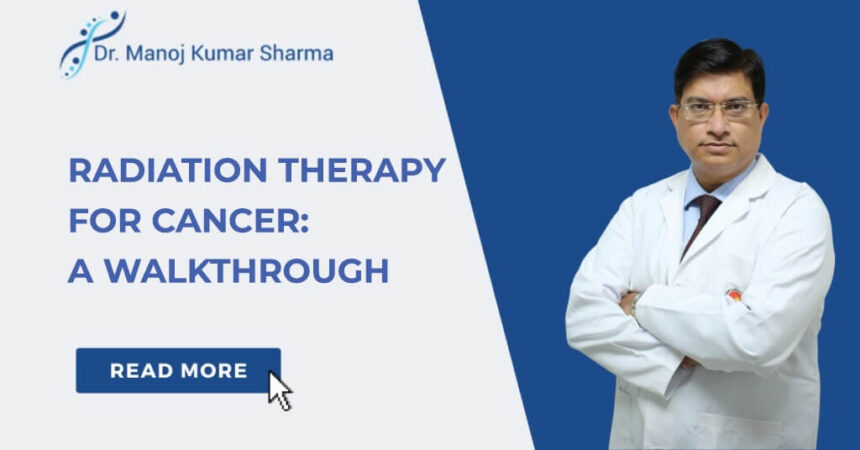Radiation therapy is a method to cure cancer by decimating or damaging cancer cells with the help of high-energy waves. The waves prevent cancer growth and the creation of new cancer cells. However, there is a risk of non-cancer cells getting damaged by the waves. Radiation therapy involves focusing high-energy waves on the spot where a tumor existed before the surgery. This way, the residual cancer cells get destroyed. Such a treatment is befitting because it enables a radiation oncologist to target only the concerned parts of your body and leave the rest untouched. Unlike this, chemotherapy impacts a patient’s entire body. Sometimes, doctors give radiation therapy along with chemotherapy. Some radiation treatments are provided by making radioactive substances flow through the mouth or veins. In this, the radiation will flow across the body and the radioactive substance will accumulate at the tumor region with minimum impact on the other body parts. “Treatments such as IGRT, IMRT, and Rapid Arc therapy can help cure cancer with minimal impact on normal tissues”, says the best radiation oncologist in Delhi, Dr. Manoj K Sharma.
Objectives of radiation therapy
Mostly, radiation therapies are not capable of destroying cancer cells spreading in several parts of the body. Still, it can be a go-to option when combined with other cancer treatments. The objectives of radiation therapy are as follows:
⦁ To control and cure cancer at first-stage: Some cancer cells are sensitive to radiation and can be dwindled or terminated by using radiation. In some cases, radiation therapy might precede surgery or take place after surgery to prevent the recurrence of cancer cells. In other scenarios, anti-cancer medications or chemotherapy might precede radiation therapy. Also, experts prefer radiation treatment for cancer types curable by surgery or radiation. It is because radiation guarantees less damage and normal functioning of the concerned body part. For some patients, anti-cancer medications, chemotherapy, and radiation might be used together. Certain medications weaken the cancer cells and result in the enhancement of radiation. Studies prove that combining radiation and anti-cancer drugs can enhance their effectiveness.
⦁ To halt the growth of cancer cells in other body parts: Cancer can spread from its origin to other regions within the body. Doctors often consider that a few cells might have already travelled to other body parts even when they are not present on imaging scans such as MRIs and CT scans. Sometimes, the tumor is close to the body part susceptible to cancer. In that case, doctors use radiation to treat existing cancer and prevent its recurrence in another body part.
⦁ To cure the signs of advanced cancer: In some cases, cancer spreads to an extent when it becomes incurable. But, doctors can treat some of these tumors in a way that makes the patient feel better. Radiation therapy might help soothe problems such as bowel blockages, trouble breathing or swallowing, or pain caused by advanced cancer. This treatment is called palliative radiation.
⦁ To treat cancer when it recurs: When cancer recurs within a patient’s body, radiation helps cure the existing disease or treat the symptoms of the advanced stage. Experts contemplate several factors to decide whether radiation should be implemented after recurrence. For example, a radiation oncologist will not apply radiation on a body part penetrated by radiation earlier. Even this decision depends on the amount of radiation applied to the concerned body part. In some cases, doctors may channel radiation in the same or different regions. Some tumors are not affected by radiation; so doctors may not use radiation even if such tumors recur.
Methods of giving radiation therapy
Radiation specialists channel radiation in the following ways:
⦁ External beam radiation – In this therapy, a machine helps channel high-energy rays from the outside into the tumor. A cancer patient is given this therapy once or twice a day over several weeks. A patient undergoing this therapy need not adhere to special safety measures at home.
⦁ Internal radiation – This therapy is also referred to as brachytherapy. The source of high-energy beams is inserted into the body near the tumor. Some brachytherapy methods involve inserting the radiation device and leaving it inside the body to work. In some cases, it is inserted for a specific period and then removed. It depends on the type of cancer. Doctors recommend special safety precautions be followed by patients undergoing this treatment.
⦁ Systemic radiation – Radioactive medications injected into the veins or given by mouth also help cure several types of cancer.
Conclusion
The type of radiation given to a cancer patient depends on the type of cancer and the region infected by it. In some cases, experts use a combination of different radiation therapies. The best oncologist in Delhi, Dr. Manoj K. Sharma can help you with the therapy prescribed for you, its impact, and precautions.

